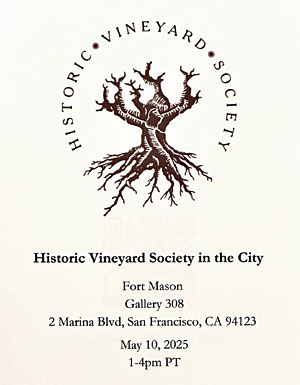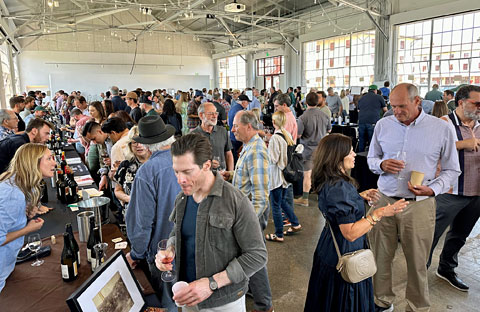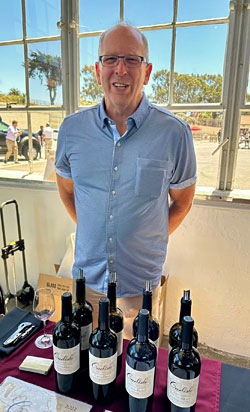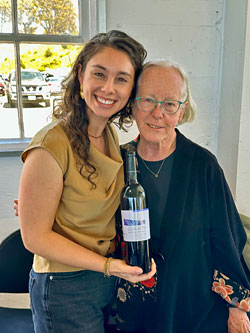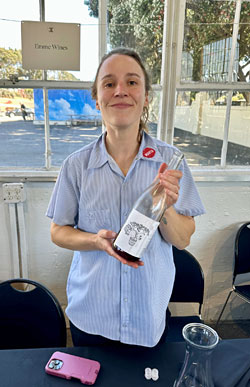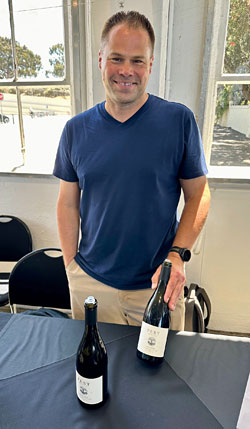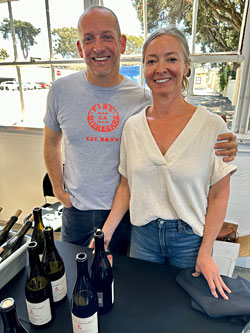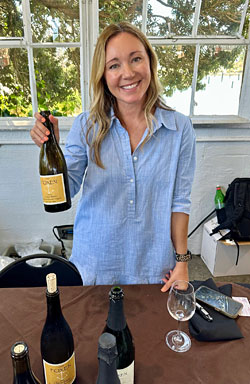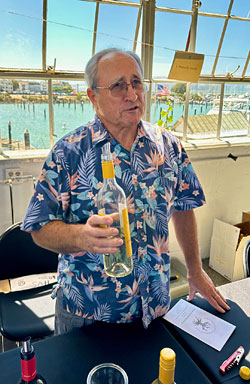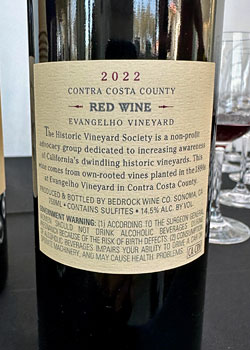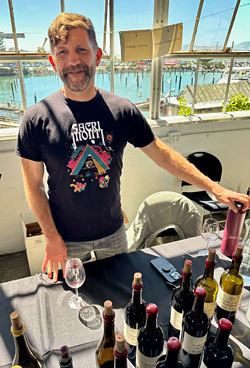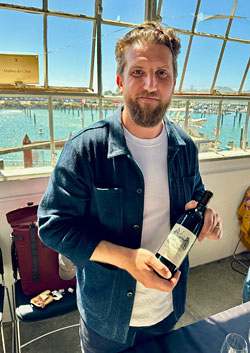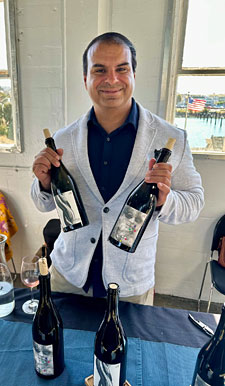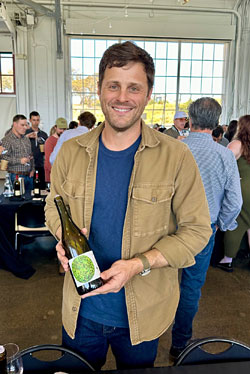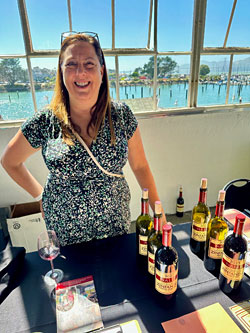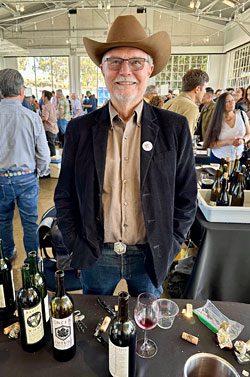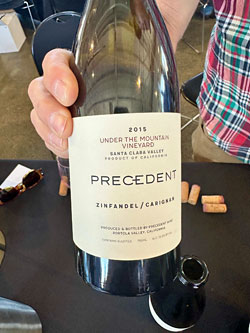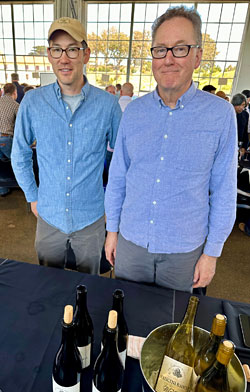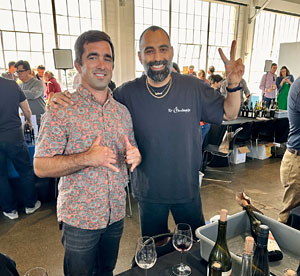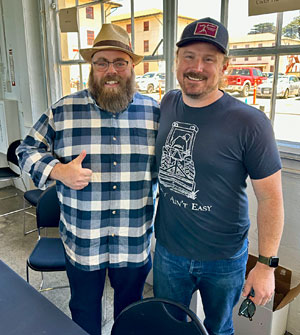Bedrock Wine Co.
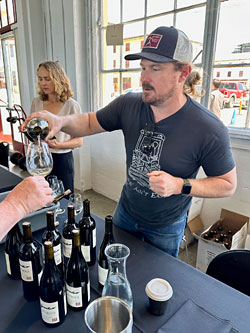 |
Bedrock’s Morgan Twain-Peterson is the son of Ravenswood winery founder and current Once & Future proprietor Joel Peterson, and he founded the label in 2007. Chris Cottrell joined Morgan as a partner in Bedrock in 2012. Morgan and Bedrock have brought much attention to the preservation of old and historic vineyards, and much of the fruit for their wines comes from old vines. Morgan poured four wines and I liked them all, with two particular highlights. The 2023 “Compagni Portis Heritage” from Sonoma Valley is a field blend of Gewürztraminer, Riesling, Trousseau Gris, and Roter Veltliner. With aromas of citrus and stone fruit, flowers, and a savory herbal note, this had medium-light body and a lively mouthfeel and finish. The 2023 Montecillo Vineyard Old Vine Cabernet Sauvignon from the Moon Mountain AVA of Sonoma County was one of my favorite Cabs at the tasting, featuring upfront dried herb aromas plus black currant, plum, and spice, medium-full body, with plenty of structure and youthful tannins.
Bucklin Old Hill Ranch
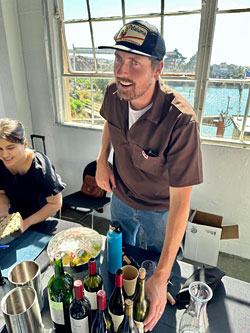 |
Founded by siblings Arden, Kate, Ted, and Will Bucklin in 2000, the winery focuses on wines from Old Hill Ranch in Sonoma Valley. The siblings’ mother Anne and her husband Otto Teller purchased Old Hill Ranch vineyard in 1981. The original grapegrower there, William Hill, had Zinfandel planted as early as the 1850s, and the oldest existing vines at the site were planted in the 1880s. I tasted four wines at the Bucklin table, and three of them especially impressed me. The 2023 Old Hill Ranch Ancient Grenache is about 85% Grenache plus Syrah, Mourvèdre, and Alicante Bouschet, and it had upfront red fruit along with herb and earth notes, medium body with a lively mouthfeel and fine structure. A field blend made up of about 35 varieties with Zinfandel being the largest component, the 2022 Old Hill Ranch Ancient Field Blend was savory and spicy, with ripe black cherry and darker berry fruit plus a touch of pepper, medium-full bodied with great structure for cellaring. Tasted from a magnum, the 2018 Old Hill Ranch Ancient Field Blend was developing nicely, showing more subtle red fruit plus earth and spice notes, still with good structure and with more resolved tannins on the finish.
Carlisle Winery & Vineyards
Proprietors Mike and Kendall Officer established their label in 1998 after Mike had been a longtime home winemaker. He’s been working with old-vine Zinfandel, Rhônes, and old field blends for many years. Mike was on hand to pour his wines at the event – I particularly liked these two, both from Russian River Valley. The 2022 Papera Ranch Zinfandel had beautiful floral aromas to go with subtle red fruit and spice, with medium body and a lively finish. A field blend with about 85% Zin, the 2023 Carlisle Vineyard Zinfandel showed a bolder profile, with upfront ripe boysenberry aromas and spice, with bigger structure and firm tannins – this promising youngster deserves some time in the cellar to develop.
Carol Shelton Wines
Carol launched her eponymous winery in 2000, after earning an enology degree from UC Davis and spending nearly 20 years as winemaker for Windsor Vineyards. She’s become particularly known for her Zinfandels, which she sources from up and down California. Carol poured her wines at the tasting and I thought two were especially noteworthy. The 2022 “Wild Thing” Old Vine Zinfandel from Mendocino County includes some Carignane and Petite Sirah, and featured lots of upfront black cherry and wild berry aromas along with earth, spice, and a peppery note, with medium weight and a long finish. The 2021 “Monga Zin” Lopez Vineyard Zinfandel from 100+ year-old vines in Cucamonga Valley was quite distinctive, with a more tart red berry profile, earth, spice, and a brambly herbal note, with plenty of structure.
Corison Winery
Winemaker Cathy Corison and her husband William Martin established Corison Winery in 1987 in Napa Valley, and in 1995 they purchased their Kronos Vineyard property in the St. Helena AVA. They added a second estate vineyard, Sunbasket, in 2015. Corison has been famed for producing some of Napa Valley’s most balanced and elegant Cabernets. Cathy and her daughter Grace were on hand, and they poured only one wine, but it was one of my favorite wines of the entire tasting. The 2021 Kronos Vineyard Cabernet Sauvignon from the St. Helena AVA of Napa Valley displayed dried herb, black cherry and currant fruit, with touches of spice and earth, medium-full bodied with great texture and refined tannins, an elegant rendition of Cabernet.
Desire Lines Wine Co.
Winemaker Cody Rasmussen and his wife Emily founded Desire Lines in 2014. Cody is also the assistant winemaker at Bedrock, and works with vineyards all over northern California for the Desire Lines wines, focusing on old vine fruit. Cody was on hand to pour the wines, and I liked all four wines that he poured, with three particular favorites. The 2021 “Experimental Series” La Jolla del Norte Vineyard Riesling from Napa Valley displayed subtle stone fruit and citrus aromas plus floral notes, medium-light weight with a long finish. The 2023 Evangelho Vineyard Red Wine from Contra Costa County includes mostly Carignan and Mourvèdre, and had an earthy character, along with plum and darker berry fruit and spice, with good structure and firm tannins. From Sonoma Valley, the 2019 “Experimental Series” Bedrock Vineyard Mourvèdre featured iron/mineral aromas, black cherry and plum fruit, earth, and dried herbs, with medium body and a lively texture and finish.
Emme Wines
Emme is the winery of owner/winemaker Rosalind Reynolds. She works with minimal-intervention winemaking, and many of her wines come from old-vine Mendocino County fruit. Her table was the last I visited at the event, so Rosalind only had time to pour one wine for me. The 2024 Ricetti Vineyard “pink lemonade” from Redwood Valley is a field blend of both white and red varieties – Zinfandel, Abouriou, Colombard, Carignan, and Valdiguié. This displayed floral aromas plus bright but subtle strawberry and cranberry notes with medium-light weight and a vibrant mouthfeel and finish. After so many big red wines at the tasting, this was a refreshing wine to wrap up the day!
Fest Wine Company
Fest works exclusively with Pinot Noir from vineyards on Sonoma Mountain. Proprietor Michael Schriefer has worked for several noted wineries in Napa and Sonoma, and his first commercial vintage for Fest was in 2019. Michael poured two vintages of the same wine at the tasting, and my favorite was the 2022 van der Kamp Vineyard Pinot Noir from the Sonoma Mountain AVA. This featured aromas of red fruit, flowers, earth, and a touch of spice, with medium body and a lively mouthfeel and long finish.
Fine Disregard Wine Co.
Fine Disregard was founded in 2015 by Mike Schieffer and Kara Maraden. Mike is the assistant winemaker for Turley, while Kara is the director of viticulture for Foley Family Farms, and both have worked for other noted wineries in Napa Valley and elsewhere. Both Mike and Kara were on hand for the event. They poured three wines at the tasting – I enjoyed all of them and had two favorites. The 2023 Chalone Vineyard Chenin Blanc had pear and stone fruit aromas plus floral undertones, medium body, and a long finish. Sourced from Evangelho and Sandy Lane vineyards, the 2023 “Los Meganos” Contra Costa County Carignane had upfront plum and black cherry fruit, with earth and spice in support, medium-bodied with plenty of structure and firm tannins. Though tasty now, both of these wines should benefit from time in the cellar for further development.
Forlorn Hope Wines
 |
Matthew and Mara Rorick are the proprietors of Forlorn Hope, which Matthew launched established in 2005. His winery and his family’s Rorick Heritage Vineyard are located near the Sierra Foothills town of Murphys in Calaveras County. Mara poured the wines at the tasting and I thought one in particular was a standout. The 2022 Rorick Heritage Vineyard Chardonnay had a savory herbal profile with subtle apple and citrus fruit in support, medium weight with great texture and a long, lively finish.
Foxen Vineyard & Winery
Located along Foxen Canyon Road in Santa Barbara County, Bill Wathen and Dick Doré founded Foxen Winery in 1985. They produce a broad range of wines, and they've been making their old-vine Chenin Blanc from Santa Maria Valley for many years. I tasted two wines at the Foxen table – their sparkling Chenin Blanc was good but on this day I preferred the still version. The 2023 Ernesto Wickenden Vineyard Chenin Blanc featured aromas of pear, spice, and earth, combining medium body with a bright mouthfeel and finish.
Graziano Family of Wines
Graziano Family of Wines includes four labels – Saint Gregory, Monte Volpe, Enotria, and Graziano. Vintner Greg Graziano has family roots in the Mendocino County wine business stretching back over a century, and his daughter is carrying on the family tradition. Greg poured several Graziano wines at the tasting, and my favorite was the 2023 Mendocino County Chenin Blanc from Heil Vineyard in Ukiah Valley. Barrel-fermented in neutral oak, this displayed pear and stone fruit aromas plus touches of spice and flowers, with medium weight on the palate and a lively mouthfeel and finish.
Historic Vineyard Society
The tasting got started as attendees entered the main space with a pour of a wine made specially for the Historic Vineyard Society. The 2022 Evangelho Vineyard Red Wine is a field blend of Carignan, Zinfandel, and Mataro from 1890s vines planted in the deep sandy soil of Contra Costa County, from lots donated to HVS by Bedrock, Birdhorse, Desire Lines, and Ridge. This was a good wine to start with, and it featured upfront ripe raspberry and black cherry aromas plus earth and an herbal note in support, medium-full bodied with fine acidity and good structure.
I. Brand & Family Winery
I. Brand & Family Wines includes three labels – La Marea (focusing on Iberian varieties), Le P'tit Paysan (value-priced varietals and blends), and I. Brand and Family (higher-end single-vineyard wines), with fruit sourced from vineyards in the northern Central Coast region. Winemaker Ian Brand poured his wines at the tasting, and I thought three of them stood out. The 2023 Massa Vineyard Chenin Blanc from Carmel Valley had stone fruit and floral notes, with medium weight and a lively texture. From Santa Clara Valley, the 2021 Besson Vineyard Grenache was fermented with 50% whole clusters, and displayed upfront red fruit with touches of flowers and spice, fine structure and bright finish. The 2022 Massa Vineyard Cabernet Sauvignon showed an herbal character along with red and black fruit, a stony mineral component, and spice, with good acidity and plenty of structure for cellaring.
|
Maître de Chai Wine
Founded in 2012 by Alex Pitts and Marty Winters, Maître de Chai is located in Berkeley. They work with a number of grape varieties, many of them sourced from older vineyards ranging from Napa and Sonoma to San Benito County to Clarksburg and Lodi. Marty poured two wines at the event, and I thought they were both highlights. Made in neutral oak, the 2023 Ellison Vineyard Sauvignon Blanc from Sonoma Mountain displayed subtle citrus, herb, and floral notes with medium-light weight on the palate and a pleasant, lively mouthfeel and finish. The 2023 Stampede Vineyard Zinfandel from the Clements Hills AVA of Lodi was fermented with some whole clusters, and had brambly red fruit, earth, spice, and pepper aromas with medium-full body and great structure for further development.
Markus Wine Co.
Located in the Lodi region, Swiss-born owner/winemaker Markus Niggli established his label in 2014. They make a variety of wines, including some from the area’s old vines. Cellarmaster Mike Bogarin was behind the winery table when I stopped there toward the end of the tasting. My favorite of the two wines I tried was the 2022 “The Church Ancient Blocks,” Church Block from the Mokelumne River AVA of Lodi, which includes about 60% Carignane, 30% Petite Sirah, and 10% Alicante Bouschet. This featured both red and black fruit aromas, earth, and a savory herbal component, with medium-full body and a lively texture.
Martha Stoumen Wines
Martha Stoumen released the first wines from her eponymous label in 2017, after working for notable producers in California, Italy, France, Germany, and New Zealand. Much of her fruit comes from Mendocino County, and she manages the farming at several of the vineyards she sources fruit from. The two wines I tasted that were sourced from Ricetti Vineyard in Redwood Valley were my favorites. The 2022 Ricetti Vineyard Valdiguié was whole-cluster fermented, and had upfront red fruit plus hints of spice and stony minerals, with fine acidity and a lively finish. Also whole-cluster fermented, the 2021 Ricetti Vineyard Carignan was earthy and peppery, with red fruit and a savory herbal note, medium-full body with plenty of structure and firm tannins.
Nalle Winery
The Nalle family has owned their vineyard property in Dry Creek Valley since 1927. The winery is run by Doug and Lee Nalle and their son Andrew, who now makes the wines. Doug and Lee started the label in 1984, and they are known as Zinfandel specialists, though there is also Carignane, Cabernet, and Merlot at their estate site and they purchase some fruit for other vineyards as well. Both wines at the Nalle table were standouts. The 2023 Dry Creek Valley Old Vine Zinfandel displayed subtle red fruit, spice, and a savory herbal note with good structure and moderate tannins. My favorite of the two wines was the 2022 Estate Old Vine 1927 Block Zinfandel – this had brighter and more upfront red berry fruit, spice, earth, and pepper aromas with good acidity, a lively texture, and refined tannins. Nalle continues to produce some of California’s more elegant renditions of Zinfandel.
Once & Future Wine
Once & Future is the new label of one of California’s legendary vintners, Joel Peterson. Joel founded the Ravenswood label in 1976 and ran it until he sold it in 2001. Once & Future, launched about ten years ago, represents Joel returning to his wine roots, making limited bottlings from small, old-vine fruit sources. Although I got to the table too late to taste the 1993 Belloni Zin that Joel had made at Ravenswood, he poured me his 2023 Belloni Vineyard Zinfandel – a field blend of mostly Zin plus Carignane, Mataro, Petite Sirah, Alicante Bouschet, and more. This was a standout, with subtle raspberry and black cherry fruit, earth, spice, savory herbs, and a touch of pepper, with medium-full body and great structure. Very nice now and should develop well for years in the cellar.
Perlegos Family Wine Co.
The parents of Jeff and John Perlegos farmed a California vineyard so it was only natural for them to follow the tradition. They purchased the historic Stampede Vineyard in the Clements Hills AVA of eastern Lodi. They sell fruit from there to a number of noted vintners and make some themselves. Jeff was behind the winery table at the tasting, and he poured two wines, both of which were noteworthy. The 2023 Mule Plane Vineyard Carignane from Mokelumne River in Lodi was fermented with 50% whole clusters, and displayed subtle earthy plum fruit plus a touch of spice, with medium body and moderate tannins. Even better was the 2023 Stampede Vineyard Zinfandel – a field blend with 85-90% Zinfandel. More restrained than many Zins at the tasting, this had bright and brambly raspberry and wild berry aromas with hints of earth and herbs, medium-full bodied with good structure and fine tannins.
Precedent Wines
Precedent is the label of Nathan Kandler, who’s also the longtime winemaker at Thomas Fogarty Winery. He began the label in 2006, and over the years he has sought out special – and typically older – vineyards for his fruit sources. Nathan was on hand to pour his wines at the event. I enjoyed all of them and thought two were standouts. The 2021 Kirschenmann Vineyard Zinfandel from the Mokelumne River AVA in Lodi displayed Zin-berry fruit, pepper, and a savory herbal note with medium body and a great lively texture and finish. From Contra Costa County, the 2021 Evangelho Vineyard Zinfandel had more subtle aromatics, with black cherry and wild berry fruit, earth, and a touch of spice, with good structure and firm tannins. Both wines have fine potential for further development with time in the cellar.
Reichwage Winery
Reichwage was established in 2014 by winemaker Max Reichwage. He’d worked for wineries in Napa, Sonoma, Italy, Burgundy, and Tasmania. The winery focus is on Pinot Noir from their Sonoma Coast estate Twin Hills Vineyard and on the old-vine white and red varieties from their Russian River Valley estate Mancini Ranch. Max was on hand at the tasting – I enjoyed all three wines he poured, with two favorites. The 2022 Mancini Ranch White Wine is a field blend of Palomino, Muscadelle, French Colombard, and a few other varieties – with bright citrus and pear aromas and touches of flowers and fresh herbs, this had medium body and a lively texture. Fermented with whole clusters, the 2021 Mancini Ranch Carignane featured subtle red fruit along with earth and spice notes, medium-bodied with great structure with fine tannins and a long finish.
Ridge Vineyards
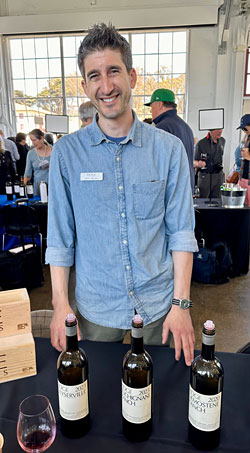 |
Ridge is one of California’s most renowned wineries, founded in 1959. Paul Draper joined Ridge in 1969 and headed their winemaking team until his retirement in 2016. John Olney now heads up the winemaking team and Shauna Rosenblum is the winemaker at the Lytton Springs facility in Sonoma County. John Musto, who’s in charge of the winery’s business insights and analytics, poured the Ridge wines at the tasting – all were very good, and I had three favorites, all from vineyards in Alexander Valley. The 2020 “Demostene Ranch” is 54% Zinfandel and 46% Carignane, and displayed earthy black cherry and spice, with medium-full body and fine structure. Composed of 61% Zinfandel and 39% Carignane, the 2023 “Buchignani Ranch” had more upfront red and black fruit plus savory herbs and earth, with a lively mouthfeel and finish. The 2023 “Geyserville” is 70% Zinfandel, 18% Carignane, 9% Petite Sirah, and 3% Alicante Bouschet. This had loads of spice along with boysenberry fruit, earth, and a touch of pepper, with a slightly bigger texture and great structure – it’s tempting already but should really benefit from time in the cellar to develop.
Robert Biale Vineyards
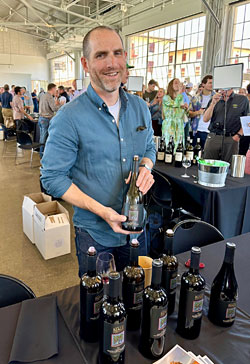 |
Founded by Robert Biale and his father Aldo in 1991, the winery is known as a specialist in old-vine Napa Valley Zinfandel and Petite Sirah, as well as Barbera and other Italian varieties. Their flagship “Black Chicken” Zinfandel is named for the 1940s code word for Aldo’s bootleg wine. Winemaker David Natali was behind the winery table at the event, and he poured a strong group of wines. The 2022 Aldo’s Vineyard Zinfandel from Napa Valley’s Oak Knoll District is a field blend of about 85% Zinfandel along with many other interplanted varieties including Carignane, Petite Sirah, Alicante Bouschet, Abouriou, and more. It featured black cherry, spice, herb, and pepper aromas, with medium weight and a nice texture. From Sonoma Valley, the 2022 Pagani Ranch Zinfandel had bolder boysenberry and spice aromas, with a bigger and more structured mouthfeel and firm tannins. The 2022 Palisades Vineyard Petite Sirah from the Calistoga area had lots of pepper along with dark berry fruit and a floral note, full-bodied with plenty of structure and surprisingly fine tannins.
Sandlands Vineyards
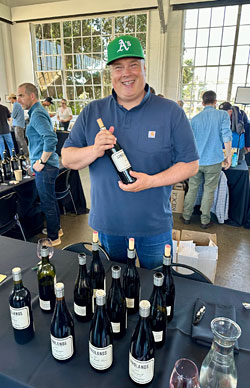 |
Sandlands is the label of Turley winemaker Tegan Passalacqua and his wife Olivia. The focus is on older grape varieties of California – such as Chenin Blanc, Carignane, Trousseau, and Mataro – and mostly sourced from old vines. Tegan searches out nearly-forgotten vineyards, particularly those with sandy decomposed granite soil. The first vintage for the Sandlands wines was in 2010. Tegan poured his wines at the tasting – all four were very good with three favorites. The 2023 Lodi Cinsault from Bechthold Vineyard displayed bright red fruit, a savory herbal component, and a subtle floral note, with a lively mouthfeel and finish. The 2023 Lodi Red Wine is equal parts Zinfandel from Kirschenmann Vineyard, Cinsault from Bechthold Vineyard, and Carignane from Spenker Vineyard – this showed a more earthy and spicy character, with a somewhat darker fruit profile and bigger structure. The 2023 San Benito County Mataro from Enz Vineyard had subtle darker berry aromas along with touches of earth, iron, and smoke, with medium-full body and fine structure.
St. Amant Winery
St. Amant was established in 1981 by the Spencer family, and winemaker Stuart Spencer and his mother Barbara are the proprietors. St. Amant works with Iberian grape varieties from the family’s Amador County vineyard as well as old-vine Zinfandel and other varieties from Lodi. Stuart was on hand to pour his wines at the event, and I thought two of them were standouts. The 2023 Marian’s Vineyard Reserve Zinfandel is sourced from 120+ year old vines, and it featured upfront ripe boysenberry fruit, spice, and an herbal note, medium-bodied with a lively mouthfeel and moderate tannins. The 2023 Mohr-Fry Ranches “Heritage Red” includes around 50% Zinfandel and 25% each Alicante Bouschet and Petite Sirah. With bold darker berry aromas along with earth and spice, this had a bigger texture and firm, youthful tannins.
Stirm Wine Co.
Ryan Stirm launched his wine label with the 2013 vintage. The winery has been especially known for working with old vineyards in San Benito County. Ryan and Jehan Hakimian, his partner on the Los Chuchaquis label, were behind the winery table at the tasting. Ryan poured his wines at the tasting – I enjoyed all of them and had a couple of favorites, both from Wirz Vineyard in Cienega Valley. The 2020 Wirz Vineyard Riesling had subtle stone fruit, petrol, and floral aromas, with medium body and a lively mouthfeel and finish. The Los Chuchaquis 2023 Wirz Vineyard is a blend of Rosa del Peru (Mission) and Cabernet Pfeffer. A light, chillable red, this had bright red fruit, earth, and spice notes, medium-light weight on the palate and a long, pleasant finish.
Under the Wire Wines
For their Under the Wire label, Chris Cottrell and Morgan Twain-Peterson of Bedrock Wine Co. make sparking wines using the traditional Méthode Champenoise. They source fruit from a number of vineyards stretching from Mendocino to Monterey counties. Both Chris and Morgan were on hand to pour the Under The Wire wine at the tasting. Though there was just one wine from Under the Wire, it was a noteworthy one – the 2018 Bedrock Vineyard Sparkling Zinfandel displayed bright yet subtle red fruit with floral notes in support, and fine bubbles. |


